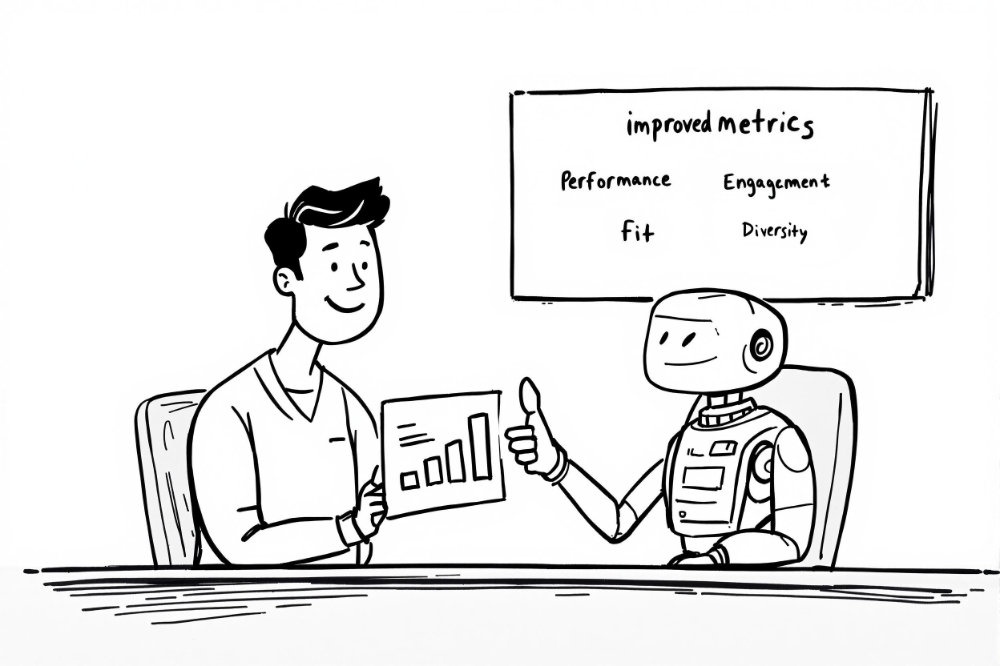There I was, staring at a spreadsheet of candidate quality metrics that made about as much sense as reading tea leaves in a hurricane. The numbers were there, the charts were neat, and yet something kept nagging at me. Why did our “star hires” keep flaming out after a few months? Where was that magical metric that would spare us the never-ending cycle of posting, praying, and politely nodding at underqualified applicants
This relentless puzzle—improving candidate quality metrics—turned into a personal quest.
Some recruiters swear by turnover rates. Others cling to job performance metrics like a lifeboat. Engaged employees, cultural fit… each metric promises salvation. But guess what? None of these alone solves the puzzle. Instead, we need a holistic approach that weaves them together into a coherent tapestry. An approach that also acknowledges the human side—our biases, our hopes, and our (sometimes irrational) decisions.
I tested a few hypotheses. I stumbled a lot. But what emerged was a newfound clarity: improving candidate quality metrics isn’t about a single number. It’s about redefining the way we think about talent.

The Curious Case of Disconnected Metrics
It feels weird, doesn’t it? We have metrics like turnover rates and employee engagement, and yet most organizations still struggle to truly elevate their hiring game. High turnover? Blame the job description. Poor cultural fit? Maybe they never felt valued. Low engagement? Perhaps the onboarding experience lacked pizzazz. Sure, each metric hints at a clue, but none solves the mystery on its own.
In reality, better candidate quality metrics rely on blending diverse data points and asking pointed questions:
- Why are we losing top talent after 90 days?
- Is our performance review system aligned with actual role demands?
- Do we measure cultural fit, or do we just assume it magically happens at the snack station?
It’s a bit like baking a cake without tasting the batter: you follow the recipe, but you never know if the final flavor is right until it’s too late.
Spoiler: Taste the batter early. That’s your secret sauce.
Turnover: The Loudest Alarm Bell
Turnover rates scream at us. Loudly. They tell us when we’ve messed up. If people keep leaving, maybe we’re not hiring for the right skills—or not setting realistic expectations. Turnover is a red alert, a neon sign flashing: Change something!
But it doesn’t tell you what to change. Is it the recruitment ads? The onboarding process? The culture itself? Turnover alone is like the fire alarm without indicating where the fire is. Helpful, but incomplete.
Still, pay attention to turnover. It’s the quickest sign that your candidate quality pipeline is springing leaks.
Performance Metrics: The Holy Grail or Just Another Number?
We’re all obsessed with job performance measures: KPIs, sales targets, or project completion rates. If a hire crushes their goals, we clap. If they fumble, we sigh. But performance metrics can be misleading. Maybe someone hit targets by working 14-hour days and will burn out next quarter. Or maybe they’re quietly brilliant at team-building but never show up in the data.
Job performance metrics need careful calibration. Align them with the actual demands of the role, not just lofty ideals.
Keep an eye on whether you’re measuring what truly matters. You can also compare new hires to your top performers. Calibrating against benchmarks helps ensure you’re hiring candidates who fit the role’s essence, not just its bullet points.
Engagement and Culture: The Subtle Threads
What about employee engagement and cultural fit? These are softer metrics, often measured through surveys, feedback loops, or 360-degree feedback. Engaged employees stick around longer. They bring new ideas, lower absenteeism, and build healthier team environments.
Cultural fit is tricky. It’s easy to define culture vaguely and end up selecting candidates who look, talk, and think the same, thereby killing diversity and innovation. Instead, define the behaviors and values that actually drive performance. Use 360-degree feedback to ensure cultural assessments aren’t one-dimensional. Also, watch out for bias. Cultural fit should mean alignment with values, not mirroring personal hobbies or who laughs at your dad jokes.
Think of engagement and culture as the invisible glue. Without them, no matter how shiny your hire’s skill set, they might never truly bond with the team.
Does Your Recruitment Process Even Know It Needs a Makeover?
You may have a killer ATS, wicked Boolean searches, and fancy predictive analytics. Yet, if your source of hire leads are stale or your candidates vanish after the second interview (like that weird cousin who shows up at family reunions but disappears after dessert), you know there’s a deeper issue.
Source analysis matters. Are your top performers coming from referrals, professional networks, or that random Slack group of data scientists who also love artisanal cheese? Understand these sources, double down on them, and trim the wasted spend elsewhere.
A sharper lens on where quality candidates originate ensures you’re fishing in the right pond.
Beyond Speed and Cost: Focus on Quality
We’re obsessed with time-to-fill and cost-per-hire, but these metrics often clash with candidate quality. More speed or less cost can mean skimping on evaluation, which leads to lower-quality hires. It’s like buying the cheapest parachute you can find and then hoping it holds up at 10,000 feet.
Quality of hire trumps speed and cost. This doesn’t mean ignore efficiency—just don’t let it bully you into poor decisions. Hiring slowly but correctly often beats hiring fast and weeping later.
The Engagement Surveys: Not Just Dust Collectors
Who actually reads those annual engagement surveys? If yours just gather digital dust, you’re missing a goldmine. Surveys and pulse checks can show how well new hires integrate. Perhaps they highlight training needs, mentorship gaps, or culture misalignment. When engagement dips, it’s a sign to revisit how you’re recruiting and who you’re bringing in.
Use these surveys regularly. Don’t just run them annually—try quick pulse surveys monthly or quarterly. Adjust your hiring based on this feedback. If you find a role consistently leads to disenchantment (like a project manager who leaves in six months every time), that’s not a coincidence. That’s a pattern screaming for attention.
Pulse surveys are real-time weather reports. Don’t wait for a year to find out it’s been raining inside your company all along.
The Subtle Art of Nurturing Talent Pools
We all love unicorn candidates—those rare creatures who match every requirement and sparkle with innovation. But waiting for unicorns is foolish. Instead, build strong talent pools and nurture candidates who might not be perfect now but could grow into your roles.
This also means tracking candidate experience. If candidates drop off your funnel at a particular stage, ask why. Maybe your tests are too long, your communication too sparse, or your interviewer too fond of awkward silences. Improve that experience, because happier candidates tend to produce better quality hires down the line.
Candidate experience is not just a warm-and-fuzzy factor—it’s a forward-looking metric for future quality hires.

The Data-Driven Paradox: Don’t Let Numbers Crush Your Soul
In a world of dashboards and analytics tools, it’s easy to get drunk on data. Be careful. Metrics without context are just noise. Interpret them thoughtfully. If job performance improves but cultural fit drops, dig deeper. Could you be valuing only short-term wins?
Combine data analysis with human judgment. For instance, consider leveraging platforms like Machine Hiring that integrate ATS functionality with advanced analytics to identify patterns in your hiring process. With a free trial, you can see how real-time data helps refine not just who you hire, but how you engage and retain them.
Machine Hiring’s capabilities in parsing and analyzing massive candidate pools can spotlight which sources are best, where engagement drops, and how onboarding correlates with long-term productivity. It’s like having a personal talent scout who never sleeps.
Multiple Interviews: A Gift or a Curse?
Some swear by multiple interview rounds. Others loathe them. When done right, multiple interviews can vet candidates thoroughly for both skill and culture. But don’t overdo it. Ten interviews only test a candidate’s patience, not their quality.
Focus on structured interviews with targeted questions. Use data from top performers to design these questions. If you’re hiring a software engineer, don’t just test coding skills—test how they solve unexpected problems. If you’re hiring a marketing manager, ask about how they handle ambiguous data. Align interviews with the metrics you care about.
Properly structured interviews are like filters that catch the right gems without driving them away.
Diversity and Inclusion: The Hidden Quality Driver
Diversity isn’t a “nice-to-have” metric. It’s a key ingredient for innovation and high-quality performance. More diverse teams often outperform homogenous ones. If your candidate pipeline yields clones, you’re missing out on fresh perspectives and adaptive strategies.
Assess how your hires perform on diverse teams, how engagement differs among various groups, and which sources yield a broader range of applicants. If your quality metrics only improve for one demographic, that’s a red flag. Adjust your outreach and assessment tools to foster inclusion. Bring in voices that challenge your assumptions, not just mirror them.
Diversity fuels resilience. Resilience leads to sustained performance. Sustained performance improves those elusive candidate quality metrics.
Continuous Improvement: Stop Waiting for “Perfect”
Candidate quality is a moving target. Markets change, skill sets evolve, and cultural norms shift. Don’t wait for the perfect formula. Start small. Test a new engagement survey format. Experiment with structured interviews. Use AI-driven tools to parse resumes and match candidates based on skills and potential, not just linear experience.
Refine your process continuously. Real-time feedback loops and pulse surveys help. Regularly review and tweak your scoring systems. The journey never ends, and that’s okay.
The Role of Tech and Tools: Embrace the Future, but Keep Your Heart
With advanced ATS and AI-driven solutions emerging, we can automate tasks that used to drain our souls. Let the algorithms handle initial resume parsing, pre-screening, and even pre-interview assessments. Focus your human energy where it matters: the personal touch, the subtle judgments, the cultural cues.
Tools like Machine Hiring help you streamline, analyze, and refine. They turn your static resume database into a dynamic talent pool. They learn from your feedback, improving accuracy over time.
Technology should empower your human judgment, not replace it.

Embrace Messy Reality: Contradictions Are Your Friends
Don’t run from contradictions. Sometimes you’ll see great performance but low engagement. Sometimes you’ll get diverse hires but lower immediate productivity. Sometimes top performers leave because they’re poached by competitors who offer better growth.
Embrace these tensions. Use them to refine your metrics and processes. Ask yourselves: Are we rewarding short-term success at the expense of long-term loyalty? Are we stuck on skills of the past instead of the skills of tomorrow?
Contradictions are signposts, not dead ends. They guide you to deeper insights.
Onboarding: The Unsung Hero
Did you know that structured onboarding can dramatically reduce early turnover and boost engagement? Those first 90 days set the tone. If your new hire struggles with unclear expectations, guess what? Your metrics will suffer. Help them acclimate, show them the ropes, introduce them to the team, and give them meaningful early wins.
A great onboarding experience translates into better job performance, cultural fit, and reduced turnover—directly improving candidate quality metrics. Treat onboarding as the bridge from potential to reality.
Candidate Experience Is a Future Investment
Treat your candidates well, even those you don’t hire. Their experiences can shape your employer brand, referrals, and pipeline health. A respectful, engaging process might mean a candidate who wasn’t right for one role might apply again later, more qualified, or refer someone stellar.
Your hiring funnel is not just a transaction—it’s a relationship. And every positive relationship eventually leads to better quality metrics.
Hire for Potential, Not Just Past Glories
If you always chase “perfect” candidates with exact skill matches, you might miss those with high potential to grow into the role. Potential is harder to measure, but it’s a crucial part of quality. The best hires often evolve beyond their initial responsibilities. Consider competency-based assessments, scenario tests, and values alignment checks.
If your metrics can capture long-term success (maybe productivity after one year, engagement growth over time), you’ll see that measuring candidate quality is not a one-shot deal. It’s a narrative unfolding.
Don’t Be a Hiring Robot
A big chunk of improving candidate quality metrics is remembering that candidates are humans, not data points. Crack a joke (tastefully) in the interview. Understand that someone might be nervous. Good metrics stem from good relationships. We’re not building an army of clones; we’re assembling a team of vibrant, flawed, lovable humans who’ll shape the future of the company.
Show your humanity. Let candidates know they matter as people, not just as KPIs.
The Small Steps that Lead to Big Gains
- Introduce structured, relevant assessments.
- Use engagement surveys and pulse checks regularly.
- Try AI-driven tools like Machine Hiring for intelligent parsing and matching. (Yes, we have a free trial!)
- Evaluate sources of hire to focus on quality over quantity.
- Continuously refine your metrics—what worked yesterday may not work tomorrow.
Over time, these small adjustments accumulate. Suddenly, your metrics start painting a clearer picture. Your hires stick around longer, perform better, fit the culture more seamlessly, and diversify your skill sets.
An Ongoing Adventure
Improving candidate quality metrics isn’t a one-time task; it’s an ongoing adventure. Metrics evolve, priorities shift, and people surprise you. Embrace the complexity. Use data wisely, but keep your human touch. Celebrate small victories, learn from failures, and never stop experimenting.
Soon, that nagging feeling—of staring at baffling spreadsheets and guessing at what went wrong—will fade. You’ll have a framework that’s robust, flexible, and aligned with real human beings, not just numbers on a dashboard.
Ready to stop chasing unicorns and start building a sustainable, high-quality talent pipeline?
Give Machine Hiring a try.
Goodbye guesswork. Hello clarity.


